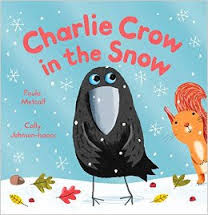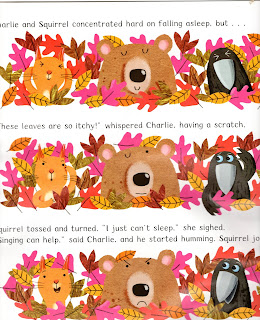Charlie Crow loves him home in the tree and enjoys visits from his friends Bear and Swallow. However, things begin to change, much to Charlie's surprise. Charlie Crow hasn't seen snow before and when he does see it for the first time he panics and goes to find his friends. He can't find bear and Swallow. However, he does bump into Squirrel who is just as confused and between them they set off to find Bear and Swallow who will surely know the answer to what is going on.
The story beautifully introduces children to the changing seasons from Autumn through to winter. Children will learn about how leaves fall from trees, water turns to ice, snow, hibernation and migration.
It would make a lovely read-aloud story for Foundation Stage and Key Stage 1. It would also make a lovely guided read for children who have mastered phase 5 phonics. In terms of comprehension there are ample opportunities to teach wither through shared or guided reading each of the 5 domains that are identified in the Key Stage 1 Reading Tests, in particular 1a vocabulary, 1b identify key aspects of fiction and 1d make inferences from the text.
The dialogue within the story uses a wide variety of synonyms for said such as squawked, whimpered, cried, shrieked and exclaimed allowing teachers the opportunity to develop children's vocabulary, consider characterisation and further children's grammatical knowledge in context.
The illustrations are bright and clearly depict the different colours and tones associated with the different seasons. Also, the expressions on the characters faces are an absolute delight. The positioning of the eyebrows on each of the characters emphasise the emotions felt by each of the characters at any one particular time and would therefore support the teaching of comprehension and emotional intelligence. My favourite, I think is the page where Charlie Crow and Squirrel attempt to hibernate with Bear.
It would make a lovely read-aloud story for Foundation Stage and Key Stage 1. It would also make a lovely guided read for children who have mastered phase 5 phonics. In terms of comprehension there are ample opportunities to teach wither through shared or guided reading each of the 5 domains that are identified in the Key Stage 1 Reading Tests, in particular 1a vocabulary, 1b identify key aspects of fiction and 1d make inferences from the text.
The dialogue within the story uses a wide variety of synonyms for said such as squawked, whimpered, cried, shrieked and exclaimed allowing teachers the opportunity to develop children's vocabulary, consider characterisation and further children's grammatical knowledge in context.
The illustrations are bright and clearly depict the different colours and tones associated with the different seasons. Also, the expressions on the characters faces are an absolute delight. The positioning of the eyebrows on each of the characters emphasise the emotions felt by each of the characters at any one particular time and would therefore support the teaching of comprehension and emotional intelligence. My favourite, I think is the page where Charlie Crow and Squirrel attempt to hibernate with Bear.
Publisher: Macmillan
Publication Date: 2013
ISBN: 978-1-4472-8155-9






